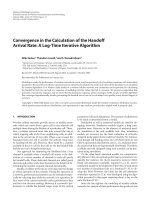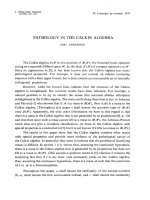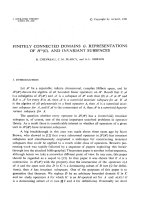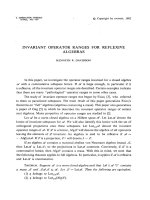Báo cáo toán học: "Convergence in distribution for subset counts between random sets" pptx
Bạn đang xem bản rút gọn của tài liệu. Xem và tải ngay bản đầy đủ của tài liệu tại đây (113.22 KB, 9 trang )
Convergence in distribution for subset counts between
random sets
Dudley Stark
School of Mathematical Sciences
Queen Mary, University of London
London E1 4NS, United Kingdom
Submitted: Jan 8, 2003; Accepted: Aug 27, 2004; Published: Sep 9, 2004
Mathematics Subject Classifications: 60C05, 60F05
Abstract
Erd˝os posed the problem of how many random subsets need to be chosen from a
set of n elements, each element appearing in each subset with probability p =1/2, in
order that at least one subset is contained in another. R´enyi answered this question,
but could not determine the limiting probability distribution for the number of
subset counts because the higher moments diverge to infinity.
The model considered by R´enyi with p arbitrary is denoted by P(m, n, p), where
m is the number of random subsets chosen. We give a necessary and sufficient
condition on p(n)andm(n) for subset counts to be asymptotically Poisson and find
rates of convergence using Stein’s method. We discuss how Poisson limits can be
shown for other statistics of P(m, n, p).
1 Introduction
Erd˝os posed the following problem which R´enyi [5] solved. Subsets S
1
,S
2
, ,S
m
are
chosen randomly from the set [1,n]:={1, 2, 3, ,n} ,wherem, n ≥ 1. For each r ∈ [1,n]
and i ∈ [1,m], the event A
r,i
:= {r ∈ S
i
} has probability P (A
r,i
)=1/2andtheA
r,i
are mutually independent. How large does m = m(n) need to be so that the probability
approaches 1 that S
i
⊆ S
j
for some pair i, j ∈ [1,m], i = j?
The model studied by R´enyi with P(A
r,i
)=p will be denoted by P(m, n, p)andmay
be considered to be a model of a random Boolean lattice when sets S
i
containing identical
elements are identified. A different random lattice model has been studied recently (in
[3, 4], for example) in which each of the possible 2
n
subsets are present independently and
with probability p.
Let X be the number of pairs (S
i
,S
j
), 1 ≤ i<j≤ n, for which either S
i
⊆ S
j
or
S
j
⊆ S
i
. If we define I
(i,j)
, i, j ∈ [1,n], i = j,byI
(i,j)
:= I [S
i
⊆ S
j
], where I[·]equals1if
the electronic journal of combinatorics 11 (2004), #R59 1
and only if the expression in brackets is true and otherwise equals 0, then
X =
1≤i=j≤n
I
(i,j)
−
1≤i<j≤n
I [S
i
= S
j
](1)
= W −
1≤i<j≤n
I [S
i
= S
j
] , (2)
where
W =
1≤i=j≤n
I
(i,j)
. (3)
Let ε
i
r
be the indicator variable of the event A
r,i
.Foreachi, j ∈ [1,m]andr ∈ [1,n], in
the model studied by R´enyi we have
P(ε
i
r
≤ ε
j
r
)=P(ε
i
r
=0)+P(ε
i
r
=1)P(ε
j
r
=1)=3/4.
The expectation EX maybecalculatedbynotingthat
EI
(i,j)
= P
r∈[1,n]
{ε
i
r
≤ ε
j
r
}
=(3/4)
n
and
EI[X
i
= X
j
]=(1/2)
n
give
EX = m(m − 1)(3/4)
n
−
m
2
(1/2)
n
∼ m
2
(3/4)
n
. (4)
R´enyi showed that for any fixed c>0, if m = m(n)satisfies
m ∼ c
2
√
3
n
, (5)
which by (4) is equivalent to lim
n→∞
EX = c
2
,then
P(X ≥ 1) = 1 − e
−c
2
.
In the model P(m, n, p), (1) becomes, with q =1−p,
EX = m(m − 1)(q + p
2
)
n
−
m
2
(p
2
+ q
2
)
n
(6)
and when p is fixed EX converges to c
2
iff m satisfies
m ∼ c (q + p
2
)
−n/2
. (7)
It is natural to suppose that the distribution of X would be approximately Poisson.
R´enyi used sieve methods for his results and was not able to prove a Poisson limit for
the electronic journal of combinatorics 11 (2004), #R59 2
X because higher moments than the fourth diverge to ∞. Poisson limits were shown,
however, for the probabilities P(X = k)whenk ≤ 3.
If p is fixed, then the argument in [5] extends easily to show that all moments of X
of a high enough order diverge to ∞ when the first moment converges. Suppose that m
satisfies (7). The τth moment of EX
τ
is bounded below by
EX
τ
≥
i
1
<i
2
···<i
τ
<j
P (A
i
1
,j
∩A
i
2
,j
∩···∩A
i
τ
,j
)
≥
m
τ +1
P
n
r=1
{ε
j
r
=1}
∼
m
τ+1
(τ +1)!
p
n
∼
c
τ+1
(τ +1)!
p(q + p
2
)
−(τ+1)/2
n
.
Thus, the τth moment diverges whenever τ>2
log p
log(q+p
2
)
− 1.
The nonconvergence of moments indicates that it is not possible to get good approx-
imation results for subset counts between random sets by using sieve methods. We use
Stein’s method to show the convergence to the Poisson distribution. Erd˝os’ problem is
thus a natural example where sieve methods fail to show convergence in distribution and
Stein’s method succeeds. Stein’s method has the advantage that it gives a rate of con-
vergence and gives Poisson approximation bounds even when moments do not converge.
For a comprehensive account of Stein’s method see [1]. In applying Stein’s method to
subset counts in P(m, n, p) we were able to use the “coupling” version of Stein’s method
and consequently were able to obtain rates of convergence in a straightforward way by
calculating certain covariances. This was not possible with other statistics of P(m, n, p)
analysed by R´enyi, for which it seems necessary to apply the “local” version of Stein’s
method.
The total variation distance between the distributions of two random variables X
1
, X
2
defined on a finite or countable state space S is defined to be
d
TV
(L(X
1
), L(X
2
)) =
1
2
s∈S
|P(X
1
= s) − P(X
2
= s)|. (8)
It is well known that
d
TV
(L(X
1
), L(X
2
)) = min
couplings
P(X
1
= X
2
), (9)
where the minimum is taken over all couplings of X
1
and X
2
on the same probability
space.
Theorem 1 Suppose that X and W are defined as (1) and (3). Let
λ := EW =
m
2
(1 − qp)
n
.
the electronic journal of combinatorics 11 (2004), #R59 3
Under these assumptions,
d
TV
(L(W ), Po(λ))
≤
1 − e
−λ
λ
m
2
+1
(1 − qp)
2n
+(m − 2)
(p
3
+ q)
n
+(p + q
3
)
n
−(2m − 3)(q
2
+ p
2
)
n
.
and
d
TV
(L(X), Po(λ))
≤
1 − e
−λ
λ
m
2
+1
(1 − qp)
2n
+(m − 2)
(p
3
+ q)
n
+(p + q
3
)
n
+
m
2
− (2m − 3)
(q
2
+ p
2
)
n
.
It follows that if p = p(n) and m = m(n) are chosen in such a way that EX converges,
then X is asymptotically Poisson if and only if simultaneously np →∞and n(1−p) →∞
as n →∞.
In Section 2 we use Stein’s method to prove Theorem 1. In Section 3 we discuss the
Poisson approximation of other statistics of P(m, n, p)consideredbyR´enyi.
2 A coupling for subset counts between random sets
In this section we prove Theorem 1.
It is convenient initially to work with the random variable W . Note that (1) implies
P(W = X)=P
i<j
{S
i
= S
j
}
≤
m
2
P(S
1
= S
2
)=
m
2
p
2
+ q
2
n
. (10)
Suppose that Γ is a finite or countable index set and that {I
α
: α ∈ Γ} are indicator
variables, possibly dependent. Let W denote W =
α∈Γ
I
α
.WesetΓ
α
=Γ\{α}
and suppose that Γ
α
can be decomposed into disjoint sets Γ
+
α
,Γ
−
α
,Γ
0
α
such that Γ
α
=
Γ
+
α
∪ Γ
+
α
∪ Γ
0
α
which have certain properties. We suppose that for each α ∈ Γthatthere
exist random variables (J
β,α
,β∈ Γ) defined on the same probability space as (I
β
,β∈ Γ)
with
L(J
β,α
,β∈ Γ) = L(I
β
,β∈ Γ|I
α
=1).
Moreover, we assume that
J
β,α
≤ I
β
if β ∈ Γ
−
α
≥ I
β
if β ∈ Γ
+
α
.
the electronic journal of combinatorics 11 (2004), #R59 4
The random variables (I
β
,β∈ Γ
−
α
) are said to be negatively related to I
α
The random
variables (I
β
,β ∈ Γ
+
α
) are said to be positively related to I
α
.Letπ
α
= EI
α
and let
λ = EW . Then Theorem 2.C of [1] gives the total variation distance bound
d
TV
(L(W ), Po(λ)) ≤
1 − e
−λ
λ
α∈Γ
π
2
α
+
α∈Γ
β∈Γ
−
α
|Cov(I
α
,I
β
)|
+
α∈Γ
β∈Γ
+
α
Cov(I
α
,I
β
)+
α∈Γ
β∈Γ
0
α
(EI
α
I
β
+ π
α
π
β
)
(11)
We will next construct the couplings needed to apply (11) to the problem of approxi-
mating the number of subset counts in P(m, n, p). We can express W as W =
(i,j)∈Γ
I
(i,j)
where
Γ={(i, j):i ∈ [1,m],j ∈ [1,m],i= j}.
The equivalent to Γ
α
in this setting is
Γ
(i,j)
= {(k, l) ∈ Γ:(k,l) =(i, j)}.
Now, define
Γ
−
(i,j)
= {(k, l) ∈ Γ
(i,j)
: {k, l}∩{i, j} = ∅}∪{(k, l) ∈ Γ
(i,j)
: l = i}∪{(k, l) ∈ Γ
(i,j)
: k = j},
Γ
+
(i,j)
= {(k, l) ∈ Γ
(i,j)
: k = i}∪{(k, l) ∈ Γ
(i,j)
: l = j},
Γ
0
(i,j)
= ∅.
Clearly, Γ
(i,j)
=Γ
−
(i,j)
∪Γ
+
(i,j)
∪Γ
0
(i,j)
. It will be shown that the indicator variables indexed by
Γ
−
(i,j)
are negatively related to I
(i,j)
and that the indicators indexed by Γ
+
(i,j)
are positively
related to I
(i,j)
.
We will now define the coupling defining J
(k,l),(i,j)
for (k, l) ∈ Γ
(i,j)
.Observethat,
conditional on I
(i,j)
=1,each(ε
i
r
,ε
j
r
), r ∈ [1,n], equals one of (0, 0), (0, 1) or (1, 1) with
the following probabilities
P((ε
i
r
,ε
j
r
)=(0, 0)) =
q
2
1 − qp
, (12)
P((ε
i
r
,ε
j
r
)=(0, 1)) =
qp
1 − qp
, (13)
P((ε
i
r
,ε
j
r
)=(1, 1)) =
p
2
1 − qp
. (14)
Given a realization of the ε
i
r
, we construct J
(k,l),(i,j)
by choosing new values of the ε
l
r
,
whichwedenoteby˜ε
l
r
, for each l ∈ [1,m]andr ∈ [1,n]. If l ∈ {i, j},thenweset˜ε
l
r
= ε
l
r
.
If (ε
i
r
,ε
j
r
) ∈{(0, 0), (0, 1), (1, 1)},thenweset(˜ε
i
r
, ˜ε
j
r
)=(ε
i
r
,ε
j
r
). If (ε
i
r
,ε
j
r
)=(1, 0), then
choose (˜ε
i
r
, ˜ε
j
r
)tobeoneof(0, 0), (0, 1), or (1, 1) randomly and with probabilities given by
the electronic journal of combinatorics 11 (2004), #R59 5
(12), (13), and (14). We let J
(k,l),(i,j)
=1if ˜ε
k
r
≤ ˜ε
l
r
for all r ∈ [1,n]andletJ
(k,l),(i,j)
=0
otherwise.
We will show that J
(k,l),(i,j)
≤ I
(k,l)
for each (k, l) ∈ Γ
−
(i,j)
. Clearly J
(k,l),(i,j)
= I
(k,l)
for
all (k, l) such that {k, l}∩{i, j} = ∅. The way the coupling is defined implies that ˜ε
i
r
≤ ε
i
r
and ˜ε
j
r
≥ ε
j
r
for all r, i, j. Therefore, we have J
(k,i),(i,j)
≤ I
(k,i)
. In the same way it follows
that J
(j,l),(i,j)
≤ I
(j,l)
.
An analogous argument shows that J
(k,l),(i,j)
≥ I
(k,l)
for all (k, l) ∈ Γ
+
(i,j)
, hence the
requirements on the indicator sets Γ
−
α
,Γ
+
α
,andΓ
0
α
in (11) have been shown to be satisfied
and we now proceed with calculating the covariances appearing therein.
If {k, l}∩{i, j} = ∅,then
Cov(I
(k,l)
,I
(i,j)
)=0. (15)
Suppose now that k ∈ [1,m] \{i}. WehaveCov(I
(k,i)
,I
(i,j)
)=E(I
(k,i)
I
(i,j)
) − (1 − qp)
2n
.
It happens that I
(k,i)
I
(i,j)
=1ifandonlyif(ε
k
r
,ε
i
r
,ε
j
r
) takes on one of the values (0, 0, 0),
(0, 0, 1), (0, 1, 1), (1, 1, 1) for each r. Hence,
E(I
(k,i)
I
(i,j)
)=(q
3
+ q
2
p + qp
2
+ p
3
)
n
=(q
2
+ p
2
)
n
and
Cov(I
(k,i)
,I
(i,j)
)=(p
2
+ q
2
)
n
−(1 − qp)
2n
. (16)
Similarly,
Cov(I
(j,l)
,I
(i,j)
)=(p
2
+ q
2
)
n
− (1 − qp)
2n
, (17)
for all l ∈ [1,m] \{j}. Note that both (16) and (17) include the case k = j, l = i,sothere
are (m −1)+(m −1)−1=2m −3 terms that contribute covariances of the form (16) and
(17). It is easily checked that (p
2
+ q
2
)
n
≤ (1 − qp)
2n
. The covariances for (k,l) ∈ Γ
+
(i,j)
equal, for k, l ∈ [1,m] \{i, j},
Cov(I
(i,l)
,I
(i,j)
)=(p
3
+ q)
n
− (1 − qp)
2n
. (18)
Cov(I
(k,j)
,I
(i,j)
)=(p + q
3
)
n
− (1 − qp)
2n
. (19)
There are m − 2 terms which contribute covariances of the form (18) and m − 2which
contribute covariances of the form (19). The covariances for (k, l) ∈ Γ
+
(i,j)
are all nonneg-
ative.
Substituting the covariances (15) through (19) in (11) gives
d
TV
(L(W ), Po(λ))
≤
1 − e
−λ
λ
m
2
(1 − qp)
2n
+(2m −3)
(1 − qp)
2n
−(p
2
+ q
2
)
n
+(m − 2)
(p
3
+ q)
n
− (1 − qp)
2n
+(m − 2)
(p + q
3
)
n
− (1 − qp)
2n
=
1 − e
−λ
λ
m
2
+1
(1 − qp)
2n
+(m −2)
(p
3
+ q)
n
+(p + q
3
)
n
−(2m − 3)(q
2
+ p
2
)
n
.
the electronic journal of combinatorics 11 (2004), #R59 6
By (10), (8) and (9), we have
d
TV
(L(X), Po(λ)) ≤ d
TV
(L(X), L(W )) + d
TV
(L(W )), Po(λ))
≤
m
2
(p
2
+ q
2
)
n
+ d
TV
(L(W )), Po(λ)).
Since (p
2
+ q
2
)
n
≤ (1 − qp)
2n
, the bound on d
TV
(L(X), Po(λ)) is of the same order
as the bound on d
TV
(L(W ), Po(λ)). If
m
2
(1 − qp)
2n
= λ(1 − p + p
2
)
n
= o(1), then
(m − 2)(p
3
+ q)
n
≤ m(1 −p + p
3
)
n
= o(1) Similarly (m − 2)(p + q
3
)
n
= o(1) and (2m −
3)(p
2
+ q
2
)
n
= o(1). The factor (1 −e
−λ
)/λ is bounded above by min(λ
−1
, 1) ≤ 1. Thus,
the total variation distances in Theorem 1 converge to 0 as long as λ(1 −p + p
2
)
n
= o(1).
This condition holds if, for example, λ is bounded and p can be written as p = ω
1
(n)/n
and p =1−ω
2
(n)/n where ω
1
(n) →∞and ω
2
(n) →∞as n →∞.
The fact that the range of p for which X has a Poisson limit when λ converges cannot
be extended beyond intervals of the form [ω
1
(n)/n, 1 − ω
2
(n)/n] is shown considering
p = c/n with c constant and fixing m. The distribution of X cannot converge weakly to
a Poisson distribution because X ≤ m
2
and a Poisson distributed variable is unbounded.
The actual limiting distribution of X can be found by the following argument. Let
Y = |{i ∈ [1,m]:S
i
= ∅}|.ThenY is asymptotically Binomial(m, e
−c
) distributed.
The expected number of elements of [1,n] occurring in more than one S
i
is n(1 − q
m
−
mpq
m−1
)=O(n
−1
)=o(1), hence by the first moment method the random variable X
asymptotically almost surely equals
Y
2
+ Y (m −Y ) which does not have a Poisson limit
by the observation above. A similar remark may be shown for p =1− c/n by redefining
Y as Y = |{i ∈ [1,m]:S
i
=[1,n]}| and considering the number of elements of [1,n]
occurring in at most m − 2oftheS
i
.
This completes the proof of Theorem 1.
3 Other statistics of randomly chosen sets
R´enyi [5] considered other statistics of P(m, n, p). For example, he considered the number
of triples (i, j, k) for which S
k
= S
i
∪S
j
; the number of triples (i, j, k) for which S
k
= S
i
∩S
j
;
and the number of r-tuples (i
1
,i
2
, ,i
r
) for which S
i
1
⊆ S
i
2
⊆···⊆ S
i
r
. These results
were extended by Bogn´ar [2] to a general theory of relations on P(m, n, p).
We could not find a direct coupling for general relations of P(m, n, p) as was done
in Section 2 for subset counts. It is possible, however, to apply the “local” version of
Stein’s method, which follows from the “coupling” version (see Corollary 2.C.5 of [1]).
We indicate how this is done by a sketch of an application of the local version of Stein’s
method to the number of triples (i, j, k) for which S
k
= S
i
∪S
j
.
In the local version of Stein’s method, for each α ∈ ΓsetsΓ
s
α
and Γ
w
α
are defined
such that Γ = Γ
s
α
∪ Γ
w
α
in such a way that I
α
is not very dependent on the indicators
the electronic journal of combinatorics 11 (2004), #R59 7
{I
β
; β ∈ Γ
w
α
}. Theorem 1.A of [1] then gives the bound
d
TV
(L(W ), Po(λ) ≤ min(1,λ
−1
)
α∈Γ
p
2
α
+ p
α
EZ
α
+ E(I
α
Z
α
)
+min(1,λ
−1/2
)
α
η
α
,
where
p
α
= EI
α
,
Z
α
=
β∈Γ
s
α
I
β
,
and
η
α
= E |E{I
α
|(I
β
,β ∈ Γ
w
α
}−p
α
|.
If I
α
is independent of the indicators (I
β
,β ∈ Γ
w
α
), then η
α
=0and
d
TV
(L(W ), Po(λ) ≤ min(1,λ
−1
)
α∈Γ
p
2
α
+ p
α
EZ
α
+ E(I
α
Z
α
)
. (20)
Consider the indicators I
i,j;k
where i, j are unordered. There are
n
2
(n − 2) such
indicators in total. We have I
i,j;k
= 1 if and only if for each τ ∈ [1,n], exactly one of the
following four options occurs:
1) τ ∈ S
i
, τ ∈ S
j
, τ ∈ S
k
2) τ ∈ S
i
, τ ∈ S
j
, τ ∈ S
k
3) τ ∈ S
i
, τ ∈ S
j
, τ ∈ S
k
4) τ ∈ S
i
, τ ∈ S
j
, τ ∈ S
k
(This is the normal disjunctive form decomposition of the relationship S
i
∪S
j
= S
k
used
in [2].) Thus, EI
1,2;3
=(q
3
+2qp
2
+ p
3
)
n
,whichisthep
α
in (20). We define
Γ
w
i,j;k
= {(l
1
,l
2
; l
3
):l
1
,l
2
,l
3
∈ {i, j, k}} and Γ
s
i,j;k
=Γ\Γ
w
i,j;k
.
For the analysis in this paragraph we will assume that λ converges and that p = q =
1/2. The indicators indexed by Γ
w
α
are clearly mutually independent of I
i,j;k
. The first
two terms in (20) vanish asymptotically. The last term is min(1,λ
−1
)
α∈Γ
E(I
α
Z
α
) ≤
E(Z
1,2;3
|I
1,2;3
= 1). The main contribution to the last expression comes from the elements
of Γ
s
α
of the form (l
1
,l
2
; k), l
1
,l
2
∈ {i, j, k}. It is easy to check that P(I
l
1
,l
2
;k
=1|I
i,j;k
=
1) = (5/8)
n
. Under our assumption that λ converges and p = q =1/2, m 2
n/3
. Hence
d
TV
(L(W ), Po(λ)=O
(2
2/3
5/8)
n
= o(1).
Clearly, similar calculations could be done for other Boolean relations on P(m, n, p).
the electronic journal of combinatorics 11 (2004), #R59 8
References
[1] Barbour, A. D., Holst, L., Janson, S. Poisson Approximation, Oxford University
Press, Oxford, 1992.
[2] Bogn´ar, K. On random sets. Magyar Tud. Akad. Mat. Kutat´oInt.K¨ol. 7 (1961)
425–440.
[3] Kohayakawa, Y., Kreuter, B., Osthus, D. The length of random subsets of Boolean
lattices. Random Structures Algorithms 16 (2000), 177–194.
[4] Osthus, D., Maximum antichains in random subsets of a finite set. J. Combin. Theory
Ser. A 90 (2000), 336–346.
[5] R´enyi, A., Egy ´altal´anos m´odszer val´osz´ın˝us´egsz´am´ıt´asi t´etelek bizony´ıt´as´ara ´es an-
nak n´eh´any alkalmaz´asa. MTA III. Oszt. K¨ozl. 11 (1961) 79–105. (Translated into
English in Selected Papers of Alfr´ed R´enyi, vol. 2, pp. 581–602, Budapest: Akad´emiai
Kiado´o.)
the electronic journal of combinatorics 11 (2004), #R59 9









